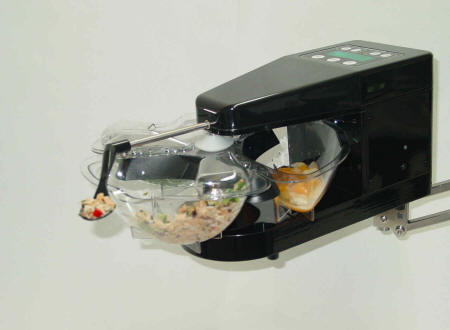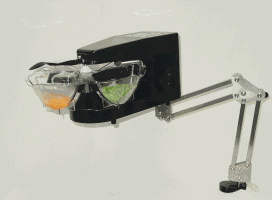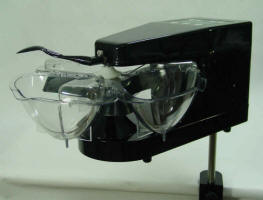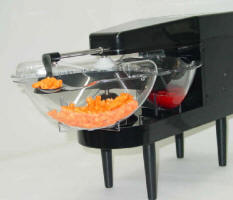January 2020 Independent Eating and Drinking Newsletter
| Independent Eating and Drinking are Wonderful |
 |
| January Newsletter Topics: |
|
| Subscribe to Newsletters |
Sitting Versus Standing to Eat
Food manufacturers invest considerable money in understanding the science of eating and drinking. They want to know what will make a product more or less appealing to consumers who potentially will eat it. In our October 2016 Newsletter we discussed The Science of Snack Food. The article described how food scientists worked to achieve the ideal balance between sugar, salt and fat to make food appealing to our palate while not having our body know how much food we have consumed, thus allowing us to overeat a specific food item. Continuing research to influence our consumption of food, marketing scientists at the University of Florida (UF) have been examining the impact of the vestibular system upon our perception of food taste. The November 2019 Newsletter examined the vestibular system and how it contributes to the bodies function. Basically, it described how the vestibular system provides information to the brain about the body’s movement, balance and location in space. Researchers at UF have been conducting studies to evaluate how posture impacts how we perceive food.
Six studies were conducted to discover the impact on taste, and awareness of food or drink temperature, caused by sitting or standing while eating or drinking. This information is important because standing is becoming more common when eating. Examples can be found in the increase in popularity of food trucks, the growing commonality of standing-only restaurants in the United States, that have been a tradition in Japan, and the increase of standing areas in popular restaurants. Restaurateurs are choosing standing while eating as a way of accommodating more customers. However, they may change their minds when they see the results of the studies being discussed.
The study results found that standing, even for a short time, increased the physical stress produced on the body, and with an increase in physical stress came a reduction is sensitivity of the taste buds. A simple test of subjects eating brownies while sitting, or standing, revealed that those eating while sitting found the brownie to be tastier than those eating while standing. This finding was consistent throughout all of the tests that were conducted. However, when salt was added to the brownies, those standing did not find the taste unpleasant while those sitting did.
When we stand, blood is drawn to the lower extremities of our body by gravity . The heart must then work to push the blood to the upper parts of our body. This increases our heart rate and increases the amount of the stress hormone cortisol that is released into our system. This, in turn, reduces our sensory sensitivity which influences how we perceive the taste of food and drink and also the awareness of its temperature. It also impacts the volume that we consumed. The ramifications of the study findings can be two fold. The study shows that in a standing position the perception of taste is reduced. This can impact the awareness of unpleasant tastes, for example when tasting the brownie with too much salt in it, subjects were less aware of the poor flavor. This could also apply to those who must consume items that have a bad taste (medicine, etc.), or those who have an altered sense of taste and find food tastes unpleasant (cancer patients who are going through chemotherapy). Secondly, for people who need to increase their calorie intake to maintain their weight due to illness or other causes, if they can sit comfortably to eat a meal they may enjoy the taste of their food more and thus eat more heartily.
The majority of research conducted relating to eating, drinking, swallowing, taste, etc., is undertaken by scientists who specialize in medical disciplines such as medical doctors, speech pathologists, nurses, occupational therapists, etc. However, this particular research was conducted by scientists whose specialty in research relating to marketing. Their research provides an entirely different view of issues relating to eating and drinking, yet was very insightful into the impact of the vestibular system on the awareness of food taste and temperature.
To read the full article about this research, published in the Journal of Consumer Research, click here.
| The Mealtime Partner Dining System |
|
Serving a Variety of Textures and Volumes
of Food and the Pace of Eating is User Controlled |
|
For those individuals who have chewing and swallowing difficulties, the Mealtime Partner Dining System can serve foods of a wide-range of textures. The device can serve regular table foods that have been cut up, or it can serve chopped, minced, or pureed foods. The amount of food present for each bite can be controlled from a level spoonful to a rounded or heaped spoonful. Thus small bites can be provided for those who should eat a small amount at a time. Food volume is controlled by the unique Bowl Covers that are attached to the bowls. |
 |
| Additionally, because the user controls when they take a bite of food from the spoon, they can pace how quickly or slowly they eat each bite of food. |
 |
| The Mealtime Partner Dining Device Presenting a Bite of Food |
| Because the Mealtime Partner is such a flexible device, it can meet the dining needs of a diverse group of individuals. For complete information about the Mealtime Partner Dining System, click here. For additional information, or for assistance selecting the best eating or drinking system(s) to serve your needs, email us at info@mealtimepartners.com, or give us a call at 800-996-8607. |
The Mealtime Partner Dining System Development and History
The Mealtime Partner Dining System is a unique product for many reasons and it is helpful to know a little about its development to understand how it came to be matchless in the world of powered dining equipment. It was the first powered dining product designed with a wide range of users in mind. Prior to its invention, dining aid products were generally made for a single individual and later put on the market for use by others, or developed to exploit a single technology that had become available (e.g., robotic arms). The problem with the single user and single technology approach to designing anything is that the product becomes specific to the needs and characteristics of one person or is constrained by the capabilities of the technology. Over the last 35 to 40 years a variety of technologies have been studied and devices constructed in an attempt to develop a device that can allow people who cannot self-feed, to do so. However, these devices have only been able to serve the needs of a small percentage of the people who need them.
The original concept for the Mealtime Partner Dining System began at The Arc of the United States (www.thearc.org) who identified the need for such a device for the large group of individuals for whom they advocate. In 1987, before starting work on developing the primary design concepts of the Assistive Dining Device (ADD), the predecessor to the Mealtime Partner, the Arc funded Southwest Research Institute (SwRI) in San Antonio, Texas, to conduct a thorough study to identify all products that aided people who were unable to feed themselves, that were commercially available, in development, or part of research projects. The search was conducted to find products throughout the world. Their final report included everything from utensils, to robots, and even monkey helpers. The study concluded that there was currently no equipment that was able to meet the criteria established by The Arc and recommended that a new device meeting their criteria be developed. The Assistive Dining Device (ADD) concept was developed with knowledge of all of the earlier powered feeding devices and was designed to overcome their shortcomings. The development of the requirements for the physical design was a collaborative effort of many experts and consumers. Its development began at The Arc of the United States and was culminated at Mealtime Partners, Inc. (Mealtime Partners) with the development of a field-test version of the Model 1 ADD.
Mealtime Partners continued the design evolution by developing a smaller, more compact, and more easily manufactured ADD, which has been named the Mealtime Partner. (It is also often referred to as, the Partner.) The Mealtime Partner was put through governmental regulatory testing. Based upon the test reports, a CB Certificate was applied for and received. The CB Certificate permits Mealtime Partners, Inc. to declare conformity with European and International Standards and place the CE Mark on the Mealtime Partner. Also, the Mealtime Partner has been classified a Class I Medical Device by the FDA.
The complete list of design criteria that was developed to form the design concept for the Mealtime Partner was extensive, some of which are considered to be Mealtime Partners proprietary information. Some of the requirements were derived from obvious problems with the earlier devices and some came from consumer ideas about what they desired in a product. In this article we will identify a few of the more obvious criteria that had been neglected in earlier designs and that were addressed in the development of the Mealtime Partner Assistive Dining Device:
-
user access to the equipment
-
food pickup
-
control of the amount of food on the spoon
-
keeping foods separated
-
speed at which the device moved
-
user control over the device operation
-
and most importantly, user safety
User access to the equipment. All devices developed, with the exception of a robotic arm named the Handy One (that is no longer on the market), required the user to sit at a table to use the equipment. For those who sit in a wheelchair at mealtimes this is limiting simply because if your wheelchair does not allow you to pull up closely enough to a table, you will be unable to use the equipment. This simple restriction excludes as many as 2/3 of the individuals who need the equipment to facilitate independent eating, from using it. Even in 2020 the Mealtime Partner Dining System is the only equipment that allows user access without it being put on a table-top for use.
To address this problem, a selection of mounting methods was developed for the Mealtime Partner. It can be mounted on the Support Arm for individuals who sit in a wheelchair to eat and who have very limited range of movement. It also makes the Partner accessible to those who sit in powered wheelchairs that, because of its size, cannot be positioned very close to a table; or wheelchairs that have controls mounted in front of the wheelchair arm that prohibit the chair from getting close to a table. Also, for those who require a lap-tray on their wheelchair, the Support Arm allows the Mealtime Partner to reach the user despite the lap-tray. The Support Arm is attached to a table (or other secure object) with the Mealtime Partner Table Clamp.
Similarly, a Mounting Shaft can position the Mealtime Partner for use with wheelchairs. They are available in lengths of 2, 4, 6, 8, and 10-inches. They are quicker and easier to adjust and less expensive than the Support Arm, but are not continuously adjustable, being available only in discrete lengths. The Shafts are also attached to a table with the Mealtime Partner Table Clamp. Following the "safety first" policy employed in the overall design of the Mealtime Partner, the shafts will allow the Mealtime Partner to rotate if it were accidentally struck, but will not rotate so freely as to move when simply touched by the user (as will the Support Arm).
Lastly, for those who can (and want to) sit at a table, additional versatility to adjust the device height is provided, by making 2, 4, and 6-inch legs available.
 |
 |
 |
| Support Arm | Mounting Shaft | Legs |
Food pickup. The inventors of the earlier devices had never seriously considered food pickup. The view was that a spoon was used and whatever food it could scoop from a plate would be picked up and brought to the user’s mouth. No provision was made for too much food or an empty spoon, both of which occurs frequently. (Being presented an empty spoon has proven to be particularly frustrating to hungry eaters). The Mealtime Partner uses a unique “gravity feed” system with bowls that contour to the shape of the spoon to reliably pick up food and steep sides to allow gravity to pull remaining food back to the bottom of the bowl.
In summary, due to a thorough analysis of all earlier dining device research and device designs, and the development of extensive user requirements by many users and experts in related fields prior to beginning the physical design (and not being constrained to any specific technology), the Mealtime Partner turned out to be the best powered dining device ever built. The multiple positioning methods and methods for control make it the only dining system that is usable by the majority of people who are unable to feed themselves. It has reliable food pickup, and controls the amount of food presented to the user. It does not mix foods and is adjustable in the speed the food will be delivered. And, it is the safest powered dining device ever built. This is why, in 2020, the Mealtime Partner Dining System is a unique product that is still unrivaled in the world of powered dining equipment.
|
Did you know? Did you know that a lot of hospitals and community clinics are being encouraged to offer their patients food when they visit the facility for medical treatment? Public health officials and anti-hunger advocates are encouraging doctors and nurses to ask all of the patients that they see, “Do you have enough food”. Many facilities are now stocking a food pantry that can provide appropriate groceries for individual needs. For example, high calorie foods for cancer patients and low sugar foods for those with diabetes. This movement is known as food pharmacies. Doctors are recognizing that if they prescribe medication and diet to a patient, if the patient does not have enough money to fill their prescription or buy food then they cannot comply with the medical advice that they receive. To avoid the stigma that may be associated with being asked if you need food, medical personnel are being encouraged to ask all of their patients. Food pharmacies are most commonly funded by grants that present an ongoing challenge for those operating them of continually finding funding. This information was reported by National Public Radio. More information can be found at this NPR website. |